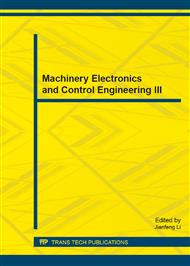[1]
D. Maltoni, D. Maio, A.K. Jain, S. Prabhakar, Handbook of Fingerprint Recognition[M], Springer, (2003).
Google Scholar
[2]
N. Ratha, R. Bolle, Automatic Fingerprint Recognition Systems[M], Springer, (2004).
Google Scholar
[3]
D. Zhang, W.K. Kong, J. You, M. Wong, Online Palmprint Identification[J], IEEE Transactions on Pattern Analysis and Machine Intelligence, 2003, 25 (9): 1041–1050.
DOI: 10.1109/tpami.2003.1227981
Google Scholar
[4]
A. Kong, D. Zhang, M. Kamel. A Survey of Palmprint Recognition[J]. Pattern Recognition, 2009, 42(7): 1408-1418.
DOI: 10.1016/j.patcog.2009.01.018
Google Scholar
[5]
Y. Ding, D. Zhuang, K. Wang. A Study of Hand Vein Recognition Method[C], IEEE International Conference on Mechatronics and Automation, 2005. IEEE, 2005, 4: 2106-2110.
DOI: 10.1109/icma.2005.1626888
Google Scholar
[6]
L. Wang, G. Leedham, D. Siu-Yeung Cho. Minutiae Feature Analysis for Infrared Hand Vein Pattern Biometrics[J]. Pattern Recognition, 2008, 41(3): 920-929.
DOI: 10.1016/j.patcog.2007.07.012
Google Scholar
[7]
D.L. Woodard, P.J. Flynn, Finger Surface as a Biometric Identifier[J], Computer Vision and Image Understanding, 2005, 100 (3): 357–384.
DOI: 10.1016/j.cviu.2005.06.003
Google Scholar
[8]
A. Kumar, C. Ravikanth, Personal Authentication Using Finger Knuckle Surface[J], IEEE Transactions on Information Forensics and Security, 2009, 4 (1): 98–109.
DOI: 10.1109/tifs.2008.2011089
Google Scholar
[9]
L. Zhang, L. Zhang, D. Zhang, H. Zhu, Online Finger–Knuckle-Print Verification for Personal Authentication[J], Pattern Recognition, 2010, 43 (7): 2560–2571.
DOI: 10.1016/j.patcog.2010.01.020
Google Scholar
[10]
G. S. Badrinath, A. Nigam, P. Gupta. An Efficient Finger-Knuckle-Print Based Recognition System Fusing Sift and Surf Matching Scores[J]. Information and Communications Security. Springer Berlin Heidelberg, 2011: 374-387.
DOI: 10.1007/978-3-642-25243-3_30
Google Scholar
[11]
L. Zhang, L. Zhang, D. Zhang, H. Zhu. Ensemble of Local and Global Information for Finger–Knuckle-Print Recognition[J]. Pattern Recognition, 2011, 44(9): 1990-(1998).
DOI: 10.1016/j.patcog.2010.06.007
Google Scholar
[12]
L. Zhang, H. Li. Encoding local image patterns using Riesz transforms: With Applications to Palmprint and Finger-Knuckle-Print Recognition[J]. Image and Vision Computing, 2012, 30(12): 1043-1051.
DOI: 10.1016/j.imavis.2012.09.003
Google Scholar
[13]
T. Ojala, M. Pietikainen, T. Maeopaa. Multiresolution Gray-Scale and Rotation Invariant Texture Classification with Local Binary Patterns[J]. IEEE Transactions on Pattern Analysis and Machine Intelligence, 2002, 24(7), 971–987.
DOI: 10.1109/tpami.2002.1017623
Google Scholar
[14]
T. Ojala, M. Pietikainen, D. Harwood. A Comparative Study of Texture Measures with Classification Based on Feature Distributions. Pattern Recognition, 1996, 29(1), 51–59.
DOI: 10.1016/0031-3203(95)00067-4
Google Scholar


